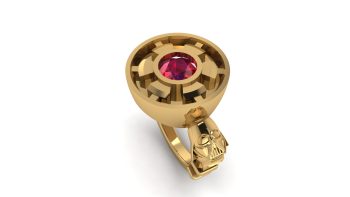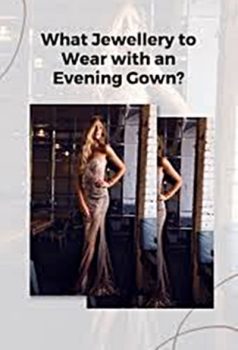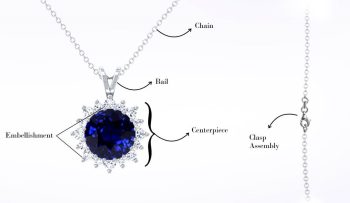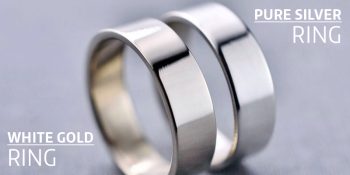Were you or a loved one born in July? If the answer is yes, then Ruby Jewelry would make the perfect gift! Rubies were one of the first gemstones discovered and have been revered for thousands of years. However, buying rubies is not always straightforward. There are natural and lab stones. But there are also a lot of treated stones on the market. These stones are worth a fraction of what comparable untreated stones are worth. Yet, you will not see treatments disclosed. This can be for nefarious reasons, but it can also be that the seller was misled by their vendor. Unfortunately, it happens in the world of precious gems. In this post we will discuss all things ruby. Hopefully, it will arm you with the info to get the best ruby for your money and needs.
What Is A Ruby?
A ruby is a precious gemstone known for its vibrant red color. It belongs to the corundum mineral family, which also includes sapphires. Rubies are formed under intense heat and pressure deep within the Earth’s crust. They are primarily found in countries such as Myanmar, Thailand, Sri Lanka, and Madagascar.
Rubies have been highly valued throughout history for their beauty and rarity. They are often associated with passion, love, and power. In ancient times, rubies were believed to possess magical properties and were used as talismans for protection and good fortune.
In addition to their aesthetic appeal, rubies are also valued for their durability. They are one of the hardest gemstones, second only to diamonds. This makes them ideal for use in jewelry, where they can withstand everyday wear and tear. Rubies are often used as center stones in engagement rings, pendants, and earrings, adding a touch of elegance and sophistication to any piece of jewelry.
History Of Ruby
Rubies have a rich history that dates back thousands of years. They were first discovered in ancient times, with the earliest records of their existence dating back to around 2000 BC. These precious gemstones were highly valued by ancient civilizations, such as the Egyptians, who believed that rubies had protective powers and bestowed good fortune upon their wearers. Rubies were also prized by the ancient Greeks and Romans, who associated them with love, passion, and vitality.
The first known source of rubies was in Myanmar, formerly known as Burma. The Burmese rubies were considered to be the finest in the world, known for their deep red color and exceptional clarity. However, rubies have also been found in other parts of the world, including Thailand, Sri Lanka, and India. In fact, some of the largest and most famous rubies in history have come from these regions.
Throughout history, rubies have been associated with royalty and the upper class. They were often used to adorn crowns, jewelry, and ceremonial objects. In medieval Europe, rubies were believed to have healing properties and were used to treat various ailments. Today, rubies continue to be highly sought after and are considered one of the most valuable gemstones in the world. Their vibrant color and timeless beauty make them a popular choice for engagement rings and other fine jewelry pieces.
Ruby Range of Colors
Rubies come in a range of colors. The most common color is a deep red, often referred to as “pigeon’s blood” red. However, rubies can also be found in shades of pink, purplish-red, and even orange-red. The color of a ruby is determined by the presence of certain elements, such as chromium or iron, in its composition. The intensity and saturation of the color can vary, with some rubies displaying a vibrant, vivid hue, while others have a more subtle, muted tone. Overall, the range of colors that rubies come in offers a variety of options for those seeking this precious gemstone.
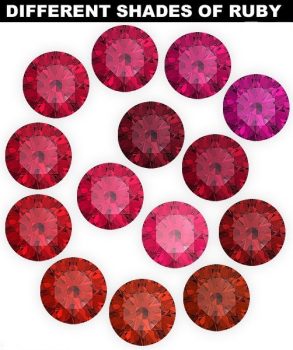
Ruby Physical Properties
Rubies are a type of gemstone known for their vibrant red color. They belong to the corundum mineral family and are composed of aluminum oxide. Rubies have a hardness of 9 on the Mohs scale, making them one of the hardest gemstones. This hardness, combined with their excellent clarity, makes rubies highly valued in the jewelry industry. Additionally, rubies have a high refractive index, which gives them a brilliant sparkle when properly cut and polished. Overall, rubies are prized for their physical properties, including their color, hardness, clarity, and brilliance.
Natural vs Lab Grown Ruby
Rubies are one of the most sought-after gemstones, known for their vibrant red color and exquisite beauty. However, not all rubies are created equal. There are natural rubies, which are formed deep within the Earth’s crust over millions of years, and lab-grown rubies, which are created in a controlled environment using advanced technology.
Natural rubies are formed when certain minerals, such as aluminum oxide, crystallize under intense heat and pressure. This process takes place over a long period of time, resulting in a gemstone that is unique and rare. On the other hand, lab-grown rubies are created in a laboratory using a process called the flame fusion method. This involves melting aluminum oxide and other minerals together to create a synthetic ruby that has the same chemical composition as a natural ruby.
So, how can you tell the difference between a natural ruby and a lab-grown one? One way is to look at the color. Natural rubies often have a slightly purplish hue, while lab-grown rubies tend to have a more vibrant red color. Additionally, natural rubies may have inclusions or imperfections, whereas lab-grown rubies are usually flawless.
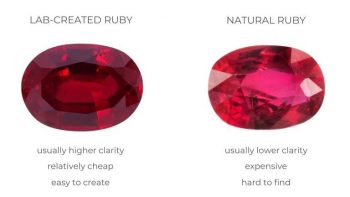
Another way to distinguish between the two is to examine the gemstone under a microscope. Natural rubies often have a natural growth pattern, while lab-grown rubies may have a more uniform appearance. Furthermore, natural rubies may exhibit a phenomenon called asterism, where a star-like pattern appears when the gemstone is cut and polished. This is rarely seen in lab-grown rubies.
Ruby Treatments
Rubies are treated in various ways to enhance their color and clarity. One common treatment is heat treatment, where the gemstone is heated to high temperatures to improve its color and remove any impurities. Another treatment is fracture filling, where the fractures or cavities in the ruby are filled with a glass-like substance to improve its clarity. These filled rubies are EVERYWHERE now. And most of the time, the treatments are not disclosed. Which is a shame, because filled rubies wholesale for about $30 a carat. Yet they are sold as unfilled all the time. Additionally, rubies can be treated with diffusion, where chemicals are used to alter the surface color of the gemstone.
To tell the difference between treated and untreated rubies, there are a few key indicators to look for. Heat-treated rubies often have a more vibrant and uniform color, while untreated rubies may have natural color zoning or variations. Fracture-filled rubies may have visible cracks or air bubbles under magnification. The bubbles are the tell tale sign though. Diffused rubies may have a color that is concentrated near the surface, with a paler color in the interior. It is important to note that these treatments are commonly used in the gemstone industry and do not necessarily diminish the value of the ruby.
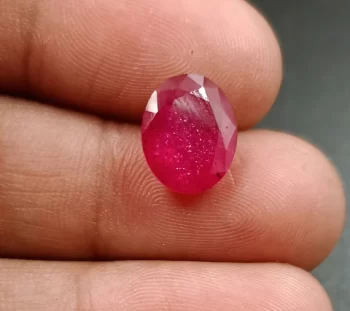
Beliefs About Ruby
Ruby jewelry holds a special place in the hearts of many. Believed to symbolize love, passion, and vitality, rubies have been cherished throughout history. With their deep red hue and exquisite beauty, ruby jewelry is often seen as a statement of elegance and luxury. Whether it’s a ruby necklace, ring, or bracelet, wearing this precious gemstone can make a bold and captivating statement. Many people believe that ruby jewelry brings good fortune and positive energy, making it a popular choice for special occasions and celebrations. Whether you’re looking to add a touch of glamour to your outfit or express your love and devotion, ruby jewelry is a timeless and meaningful choice.
Why Ruby Jewelry Is In Fashion
Ruby jewelry is currently in fashion for several reasons. Firstly, rubies are known for their vibrant red color, which adds a touch of elegance and sophistication to any outfit. Additionally, rubies are considered a symbol of love and passion, making them a popular choice for romantic occasions such as anniversaries or Valentine’s Day. Lastly, rubies are believed to have healing properties and bring good fortune to the wearer, making them not only fashionable but also meaningful accessories. So, whether you’re looking to make a fashion statement or add a meaningful touch to your jewelry collection, ruby jewelry is definitely a must-have.
Notable Rubies From the Past & Present
Rubies have long been admired for their vibrant red color and timeless beauty. Throughout history, there have been several notable rubies that have captured the attention of gem enthusiasts around the world.
One such ruby is the Sunrise Ruby, a 25.59-carat gemstone known for its exceptional color and clarity. Discovered in Myanmar in the 1990s, this ruby is considered one of the finest in the world. Its intense pigeon blood red hue, combined with its remarkable transparency, makes it a truly remarkable gem.
Another notable ruby is the Hope Ruby, a 32.08-carat gem that is famous for its rich, deep red color. This stunning ruby was once part of the collection of the renowned gem dealer, Henry Philip Hope. Today, it is considered one of the most important rubies in existence and is highly sought after by collectors.
In recent years, a new ruby has emerged as a standout in the world of gemstones. The Graff Ruby, a 8.62-carat gemstone, is known for its exceptional color and extraordinary size. This ruby, which was discovered in Mozambique, exhibits a vivid red hue that is truly captivating. Its large size and remarkable quality make it a true treasure for any gem enthusiast.
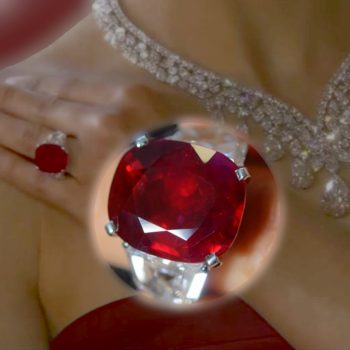
How To Care For Ruby Jewelry
Ruby jewelry is not only beautiful, but also requires proper care to maintain its brilliance and longevity. To ensure your ruby jewelry remains in pristine condition, follow these simple care tips.
First, avoid exposing your ruby jewelry to harsh chemicals, such as household cleaners or perfumes. These substances can damage the gemstone and cause it to lose its luster. Instead, remove your ruby jewelry before using any cleaning products or applying perfumes.
Second, store your ruby jewelry in a separate compartment or pouch to prevent scratching. Rubies are relatively hard gemstones, but they can still be damaged by other jewelry pieces. Keeping your ruby jewelry separate will help preserve its shine and prevent any unwanted scratches.
Last, clean your ruby jewelry regularly to maintain its brilliance. Use a soft cloth or a mild soap and warm water solution to gently clean the gemstone. Avoid using abrasive materials or harsh chemicals, as they can damage the ruby. After cleaning, pat dry with a soft cloth and store it in a safe place.
By following these care tips, you can ensure that your ruby jewelry remains beautiful and radiant for years to come. Remember to always handle your ruby jewelry with care and seek professional assistance if needed.
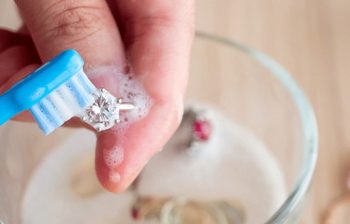
What Does Ruby Cost?
Rubies can vary greatly in cost depending on a variety of factors. Factors that influence the price of rubies include their size, color, clarity, and overall quality. Larger rubies with intense, vivid red hues are generally more expensive than smaller ones with lighter shades. Additionally, rubies that are free from any visible flaws or inclusions are considered more valuable. The origin of the ruby, whether it is from Burma, Mozambique, or another source, can also impact its price. Overall, the cost of natural rubies can range from 50 dollars to several thousand dollars per carat. But you get what you pay for. A Ruby costing $50 a carat will be an opaque reddish piece of garbage.
Lab rubies wholesale around $20 a carat while diffused stones (though not as common) can cost double that. We don’t recommend glass filled rubies. They are not stable and will end up being thrown away once the filling leeches out.
Let Us Create Your Ruby Jewelry
We create custom jewelry made to order. That is it. So we are biased when we say that we think Ruby Jewelry should be custom made. When we ruby jewelry for someone, we source the stone just for that job. That means, you can pick from any stone available for sale at that moment. In a big box retail store, you will have to choose from what they have in stock. We also have a GIA GG on hand to make sure the stone is what we say it is. So, you will never receive a treated stone if we say it is untreated.
You can view our portfolio of custom engagement rings or custom pendants to look for ideas. Or you can contact us with your own idea.. You know what they (we) say. Once you go custom, you never go back. To the mall!

